7667766266
enquiry@shankarias.in
The UK government reached a landmark deal with the European Union (EU) on post-Brexit trade rules related to governing the Northern Ireland.

Great Britain – England + Scotland + Wales
United Kingdom – Great Britain + Northern Ireland
